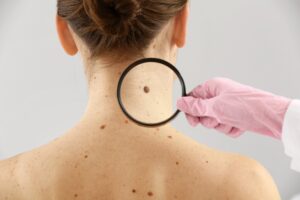We have come a long way from the days when using baby oil to acquire a beautiful tan was all the rage. Even though most people are aware just how dangerous the sun is, there are still sun worshippers who think they are invulnerable, and only a couple of hours in the sun won’t hurt.
We beg to differ.
Skin cancer is the most common form of cancer in the United States with more cases than any other cancer combined. No matter your age, your nationality, or especially if you are a parent, be aware of the dangers of skin cancer and melanoma.
 26
26
Spotting Skin Cancer
No one needs to wait for their annual doctor’s appointment to spot skin cancer. Make it a practice to do a monthly check of your skin for any changes in moles or lesions. The more frequently you assess these spots, the easier it will be to notice if something has grown or changed in shape or color.
If anything seems amiss, see a Southwest Diagnostic Center Expert right away. The smaller the spot and the sooner you get a diagnosis, the easier it will be to treat and cure.
Melanoma is the deadliest form of skin cancer, whereas Squamous cell and Basal cell skin cancers are more common forms and also more easily cured if caught early.
Use The ABCDE Method
Melanoma can develop anywhere, even in places you least expect. In men it develops more frequently on the face, while in women it tends to occur on the lower legs.
There is a simple method to spot melanoma: ABCDE.
- A stands for Asymmetry. Note if one side of the mole doesn’t match the other.
- B stands for Border. Look for a mole where the edges are irregular or blurred.
- C stands for Color. If there are different shades and colors throughout the mole, it could be melanoma. Sometimes there may be black, brown and even red, pink or white included.
- D is for Diameter. Watch out for moles larger than one quarter inch or about the size of a pencil eraser.
- E is for Evolving. You will notice changes in the size, shape, or color of the mole.
Risk Factors
Although anyone is susceptible to melanoma and skin cancers, there are some people more at risk than others. Some of them include:
- Fair skinned people who are less protected from the sun due to less melanin in their skin. This holds true for light haired people and redheads.
- Those with a history of skin cancer in their family.
- Anyone with a job that excessively exposes them to the sun.
- Those who consistently sunbathe or tan. This includes people who have used tanning beds and lamps.
- People who live in warmer climates and those living at high altitudes.
- Anyone who has a history of sunburns from their childhood or teens.
- People with a weakened immune system.
- A person with many moles.
- Protect Yourself
- Wear sunscreen whenever you are out in the sun, and protect your children especially at the beach or when outdoors for any length of time. Clouds are not protection from the UV rays.
- Avoid being outside in the middle of the day from 10 am until 2 PM if possible.
Protect Yourself
Wear sunscreen whenever you are out in the sun, and protect your children especially at the beach or when outdoors for any length of time. Clouds are not protection from the UV rays. Avoid being outside in the middle of the day from 10 am until 2 PM if possible.
In addition, wear protective clothing like hats with brims and sunglasses, and use sunscreen throughout the year.
There are countless skin products on the market with SPF as well as self tanning options. You can still get that glow without endangering your life and prematurely aging your skin.
Schedule a Skin Cancer Screening in Dallas, TX
Southwest Diagnostic Center for Molecular Imaging offers comprehensive skin cancer screening for patients in Dallas, TX. For more information or to schedule a consultation, please contact our office center at (214) 345-8300 today!


 26
26